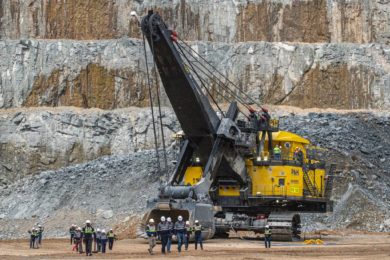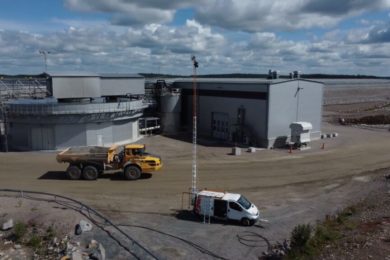Anton Potapov, CTO, VIST Robotics (now a subsidary of ZYFRA Group) recently gave his take on the near term trends on automation in mining. A few years ago, world mining leaders launched a large-scale process of updating their own fleets of equipment. Acumen Research and Consulting (ARC) estimates that the global mining equipment market will reach $285.5 billion worldwide by 2026. “At the same time, the main drivers of the growth will be automated technologies and so-called ‘smart’ solutions for the production. Already now the most advanced ‘miners’ perform a number of technological processes, such as drilling and transportation of raw materials, with the use of robotics, while in 2019 the majority of industry players may start using new technologies on an industrial scale.”
Analysts at Technavio predict the growth of the robotics market in the mining industry by an average of 27.01% by 2022. “On the very eve of the New Year, transnational mining and metallurgical company Rio Tinto, which was one of the first to build its own ‘mine of the future’, officially announced the launch of the world’s first AutoHaul autonomous long-distance railway network for the transportation of iron ore to the ports of the company in the Pilbara Region in Western Australia. The company’s ten-year work on the creation of the largest railway robot should lead to an increase in the ore production in Pilbara from 340 million to 360 million tonnes.”
At the same time, in the other hemisphere, Swedish technology companies, including Ericsson, Scania, Epiroc and SKF, are joining together in the Swedish Mining Automation Group (SMAG) and are beginning to promote their own products and technologies for mining companies. Sweden is currently not among the top mining countries, and therefore SMAG started its cooperation with Canadian companies that hope in the short term to upgrade their own production and to start using the innovative technology with the help of the concern.
“In 2019, manufacturers of industrial robotics will increasingly resort to international cooperation to expand the market and introduce new technological solutions in mining. At the same time, the leading players in the robotics market should be ready for the increased competition and emergence of new companies that have not previously worked in the mining sector. A few years ago, there was practically no alternative in the market of unmanned trucks, such companies as Caterpillar and Komatsu fully met the needs of miners in autonomous transport. In 2018, the Swedish automaker Volvo signed an agreement with the Norwegian mining company Brønnøy Kalk, according to which Volvo unmanned trucks will carry limestone on a three-mile route between the mine and the port. It is planned that in 2019 the system will operate to the full extent.”
In Morocco, a Terex mining truck with robotic control developed by VIST Robotics has passed successful trials at a special test site at the operations of phosphate miner OCP. In Russia, autonomous BELAZ trucks are already being used by Siberian coal and energy company SUEK in Khakassia. At the moment, the first robot dump truck has been assembled and successfully passed along the route of the mine haulage in an offline mode, while the process of assembling and equipping a second dump truck, as well as building the infrastructure necessary for the operation of autonomous machines is being carried out. In Kazakhstan, VIST Robotics together with the Nazarbayev University started to work on the truck tractor based on the KAMAZ NEO truck. In addition to unmanned trucks, the company is testing a robotic drilling system. It is planned that the developed product will replace a person in particularly dangerous production conditions, while the cost of drilling wells will remain at the same level or even decrease. The company expects to see the first test results in the second quarter of 2019.
“Companies engaged in the development of unmanned aerial vehicles can also start to increase production, as mining companies are finding new and new applications for drones. Drones are most actively used for the exploration and testing of equipment in hard-to-reach places. Drones make 3D maps of the fields, which are then analysed using Big Data technologies to assess the potential of the mine. Unmanned aerial vehicles help to avoid emergency situations in the quarries, tracking the process of explosive operations and traffic.”
Australian mining giant BHP Billiton, known for its active introduction of drones into production, announced the beginning of using drones in sea freight in the experimental mode. The company intends to use drones to check the status of the holds of vessels before flights. Unmanned vehicles will replace the person and will independently record meter readings, look for the damage that cannot be seen with the naked eye and transmit the image in the 4K format to the operator. The expansion of the use of robotic and automated technologies in the mining industry is made possible by reducing the cost of innovative products.
According to a McKinsey report, over the past 30 years, the average price of a robot has fallen by half in real terms, and even more in relation to labour costs. Analysts believe that demand from emerging economies encourages robot manufacturers to switch to cheaper regions, and robotics will continue to fall in price. Mines, which will use only robots, which will be controlled by robots, are no longer a fantasy. In 2019, one of the first of such projects may be implemented.
Resolute Mining announced that its gold mine Syama in Mali will be the first in the world to become fully autonomous. A fibre-optic network will be created throughout the mine, ensuring constant contact of autonomous tractors, robot drillers and ground-based control centres. “A report of the consulting company BDO Australia says that by 2020, more than 50% of miners around the world will be replaced by robots. Such forecasts sound very encouraging for manufacturers of industrial robotics and at the same time impose a great responsibility on the companies that will need to develop more advanced technical solutions to fully replace people. Manufacturers of robotic equipment also have to pay special attention to the protection of devices after massive virus attacks on industrial facilities in 2018. BDO Australia analysts believe that by 2020, activist hackers will launch at least five global cyberattacks with permanent denial of service (PDO) at mines through connected devices.”
He concludes: “Not less and perhaps more significant obstacle to the final transition to the use of robotics in mining is still the problem of employment of workers whose work is being performed by the machine. Governments cannot allow unemployment to rise, even though the costs of production automation have been reduced. There is a difficult situation, as the contradictions between effective business and social responsibility in the coming year will only grow. Only a joint effort of states, mining companies and manufacturers of robotics will help to find a way that will suit all players in the industry.”










